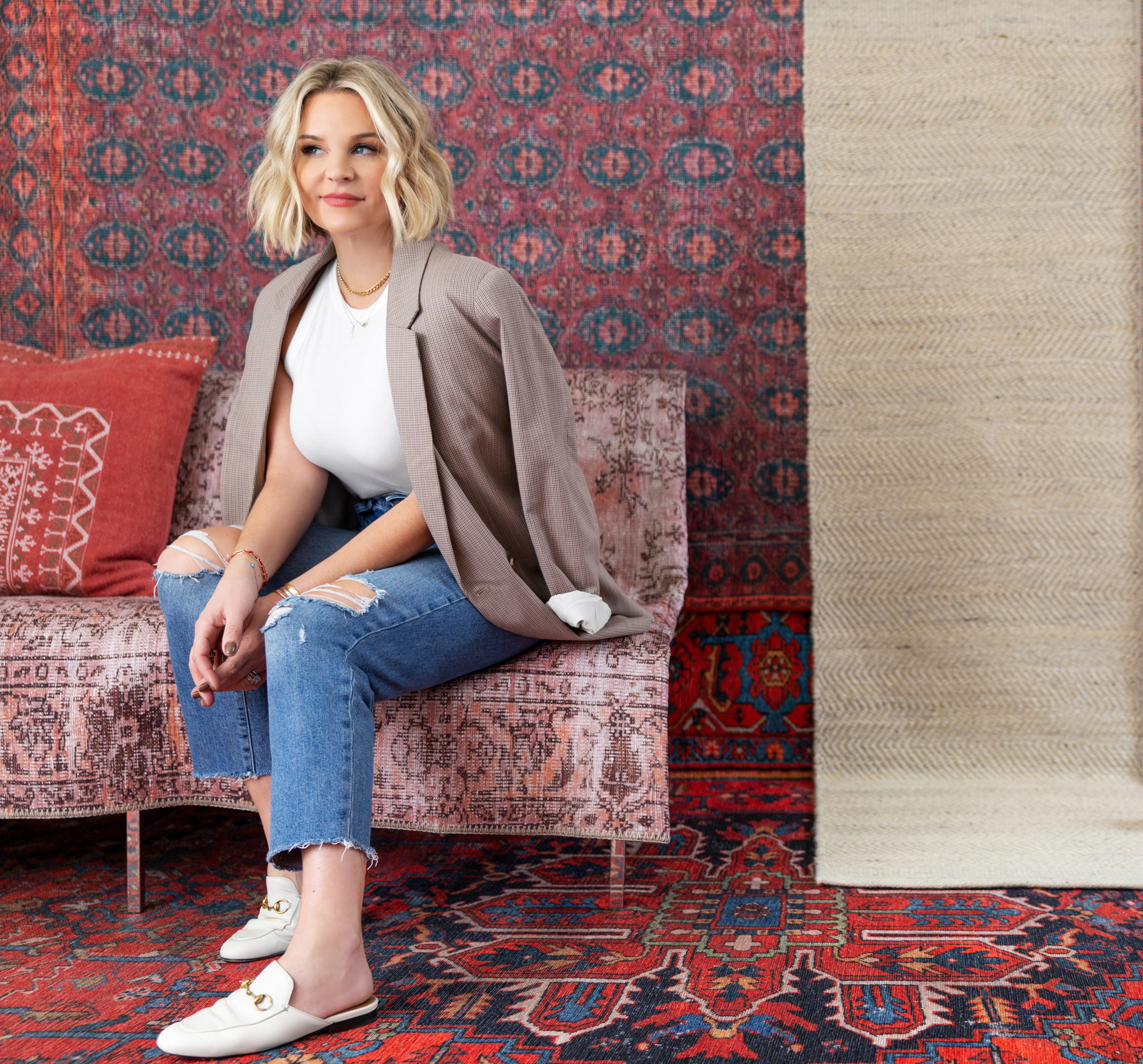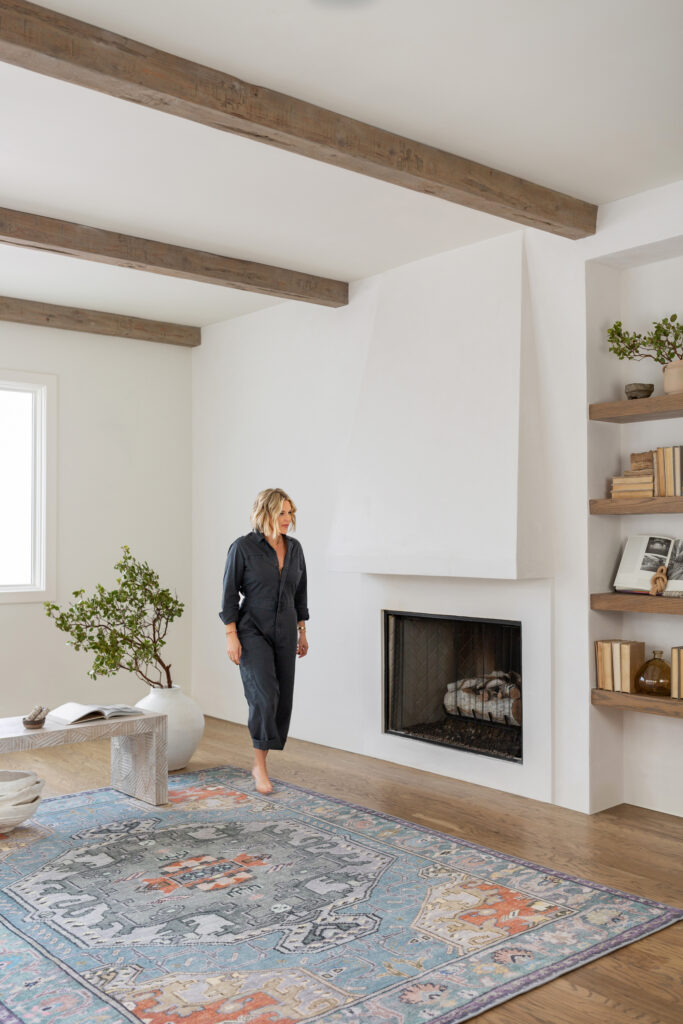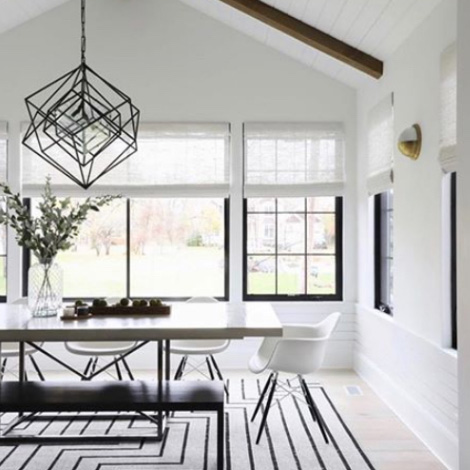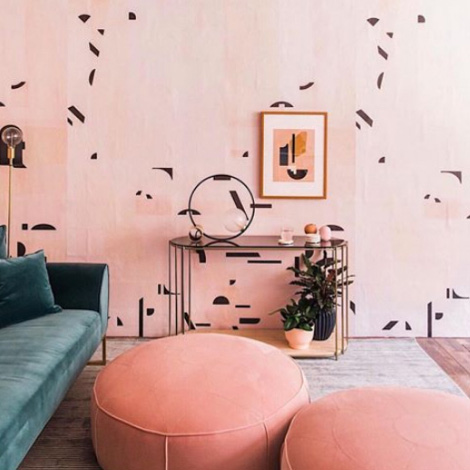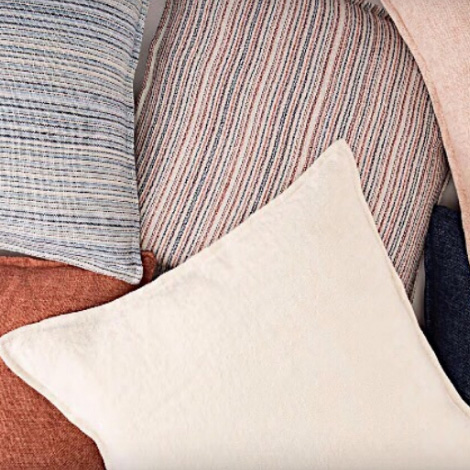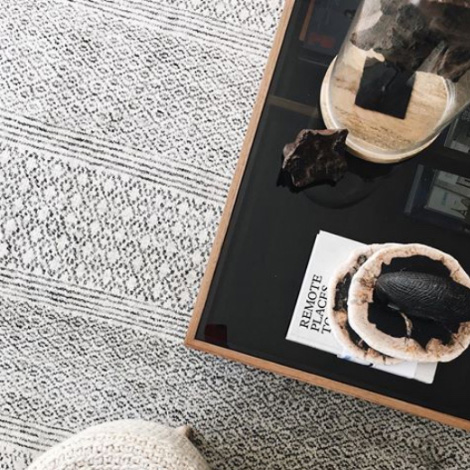“Don’t be boring.” Words to live by, but also Kate Lester‘s interior design ethos. From the story behind the names for her Harman and Harman Natural collections with Jaipur Living and how’s she’s styling them to choosing the perfect rug for each room and making a house feel like home for her clients, take a deep dive into the tastemaker’s design world.
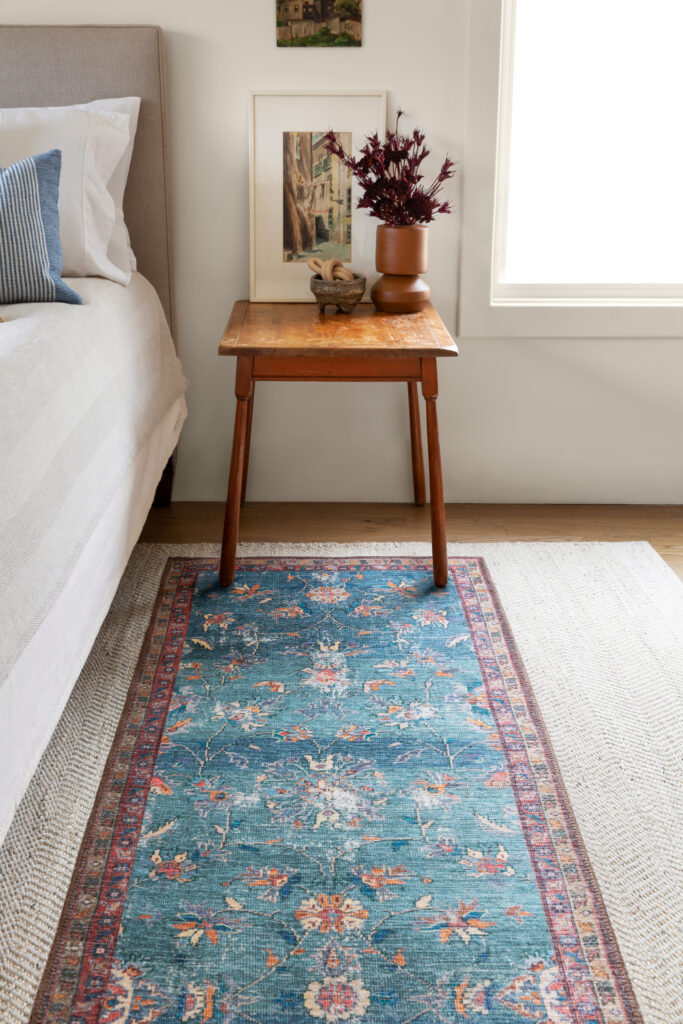
The Yasha rug from the Harman by Kate Lester collection sits pretty atop Harman Natural‘s Esdras rug.
What inspired the names for your Harman and Harman Natural collections with Jaipur Living?
Harman is the name of the collection, which in Turkish means ‘blend.’ I love the idea of that encompassing everything. It could mean a blending of cultures. It could mean a blending of textures, color, pattern, and blending my love for vintage and a more modern take on that whole experience.
How do they speak to a blending?
The Harman Natural rugs are so great because they’re versatile enough to blend with an existing rug, so you can layer them. It takes you back to the idea of more is more and blending a vintage with a natural or an existing rug you already have.
Do both collections speak to your design aesthetic?
My design aesthetic has always been embracing vintage. It’s making old new again and fresh and giving the rooms we design a sense of curation and personality. Being able to give that to a wider audience so they don’t have to schlep at the flea markets for vintage treasures like I do every weekend is really exciting for me. It’s giving them a piece of that curated aesthetic and making it so much more readily available.
For more from Kate Lester’s conversation with Jaipur Living, watch the video below and tune in to our Trade Talk series on Instagram.
Can you put a name to your interior style?
Authenticity has always been something really important to me—that our designs are not only authentic to my style, which is curated and classic and chic, but really authentic to our clients and the people who live in the homes we design. I want people to know that those are my designs, but really and truly those are the homes of the people who we are designing for. Every home should tell a story about the people who live there. And that’s really, really important to me.
What story does each collection tell?
For the Harman collection, for the vintage inspired looks, it was all about creating a collection that gives a wider audience an idea of a whole vintage vibe without having to invest or source or climb through piles of vintage carpets or travel across the world like designers do. It’s giving people these rich colors and patterns and textures they may not have had access to before. It enables them to get these rugs and give their spaces so much more personality and a little bit of history.
Each collection was designed from a true vintage rug we had sourced on travels and through our findings in the backs of vans and flea markets. Each of those were then used as a jumping off point to create an actual rug and color scheme and patterns for this collection. I wanted these to feel true and really have a sense of as much history and as much interest as we can get in a manmade collection—something that’s machine-made and not made by hand. And that’s OK. It gives our customers and our clients durability and the ability to source in all difference sizes, which I love and you can’t do with true vintage. It enables people to get more comfortable with the whole vintage movement in general.
See also: Behind-The-Scenes: Kate Lester + Jaipur Living
How are you styling the Harman and Harman Natural collections?
A good vintage rug can literally be used anywhere. I’ve taken a prayer rug and framed it and used it as a piece of art. I’ve placed a runner in a boring kitchen. Maybe you wanted to go safe with your cabinets—all white—OK, I get it, but then add in an infusion of color and pattern with a great vintage runner. Everything about these rugs—there’s a sense of vibrancy. There’s also a sense of forgiveness. They’re full of pattern and color, so spills are not a big deal. You’re not going to notice those little forgetful drops of avocado or ketchup on something like this as much as you are on something like a white wool carpet. Not only are they more interesting, but they’re more durable, and I think they create a sense of character and a talking point you may not otherwise get with something you bought off the rack.
What role do rugs play in a space? Are they the foundation or the finishing touch?
When we’re design a space, we almost always start with a piece art or a rug. Every room has to have that inspiration point—that jumping off point—at least in our office. That gets tacked up on the board with a couple of other inspiration pieces, like a fabric or a palette from a magazine. But you have to have a jumping off point—otherwise you’re designing blindly and you don’t have a direction. A rug is a great way to anchor a space and rein in on a color palette and a pattern palette. It makes things less overwhelming when you can start with a really beautiful piece and build a room from it.
Are there rules to selecting the perfect rug for each room?
When you’re doing construction, building, or remodeling and you’re getting ready to move on to phase two, which is what we call the furnishings phase—the fun phase—a lot people are honestly paralyzed with fear. They don’t know where to start, so I recommend looking at the materials you already have in the space and taking that into consideration. Get some samples of those materials, even if they’re already installed, like a chip of paint, or maybe a piece of your hardware, or a tiny bit of your countertop, then lay those out with a sample of the rug you’re considering. It’s really helpful to see all those things together. Maybe they won’t be directly on top of each other, but how the colors and movements and patterns influence each other is really important. It will help you easily make a decision in a much more quick fashion than if you were to be doing it where you’re buying the rug, laying it out, rolling it up, returning it. Getting the samples, laying them out with all the materials—sometimes it just makes the decision for you. You can tell if it’s a yes, or if it’s a no, done.
Does a rug’s feel underfoot inform your selection?
We all want the things we want, but we also have to remember who we are. What does your family look like, what does your living situation look like, are your kids running in and out with sand or mud, do you live alone, do you have pets? I think answering all those questions before you even start shopping for a rug is really important. That doesn’t mean you can’t have a fabulous rug if you have a family. You can still have nice things. You just have to keep your kids outside—I’m kidding. But I love the idea of these machine-made vintage-inspired rugs because I have a family. I have a daughter who’s full of avocado face all the time and sometimes I don’t even want her in the room with a good rug. Like I get it. But I love the idea that we’ve reproduced these vibes and patterns and colors and textures and not only are they a lot more durable, but they’re a little bit softer than a true vintage rug. I love that. I love that your baby can crawl around on it and you don’t have to worry about if there are fleas from 1990 on there. It’s a really great opportunity for you to feel excited about a brand new rug that looks really old and fabulous.
I’m also a firm believer in using the good china every day. Who’s good enough for the good china besides me? I worked to get the good china. That’s how I feel about rugs. Right now I’m trying to get my daughter to drink more green juice every day. She does not like vegetables, so I’m encouraging her to do one little small glass of green juice every day. The other day she was being extra dramatic and she decided to gag and projectile spit the green juice all over my vintage rug in the kitchen. So she doesn’t live with us anymore, but the rug is fine. I’m joking. But if you had the ability to have those rugs more easily cleaned, you would be a lot more happy than I was that day.
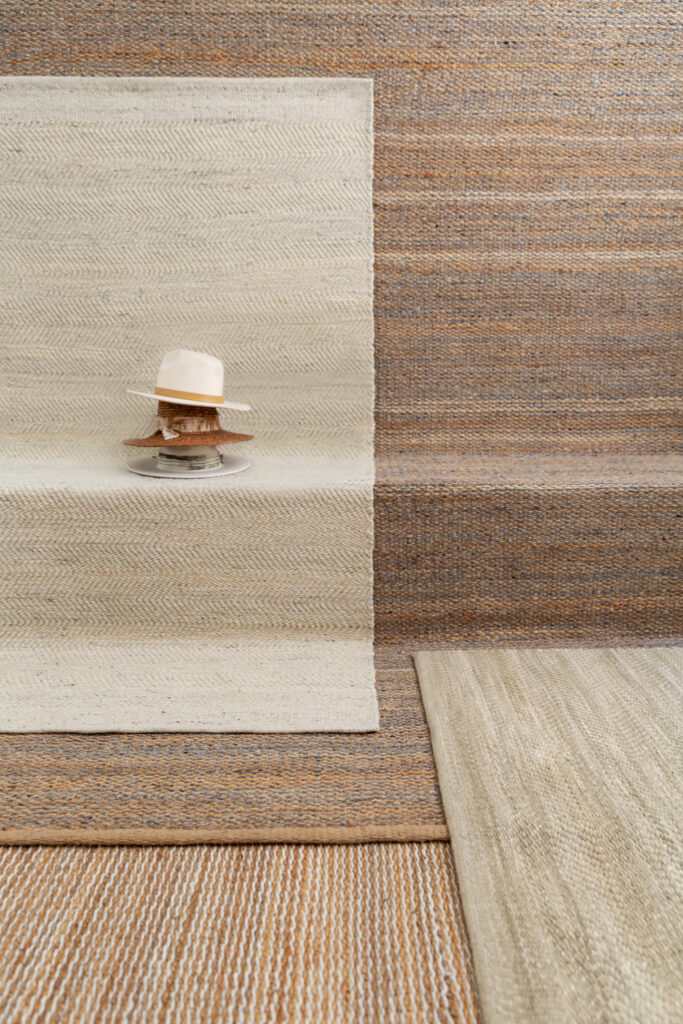
The Harman Natural by Kate Lester collection counts five styles, including Rosier and Esdras rugs, which are handcrafted from a mix of wool and jute for a softer feel underfoot.
How do you balance buying new pieces and giving fresh life to vintage treasures?
When you’re building a space and you want to infuse character and a sense of history, you do want to add in vintage pieces. There’s just a fine line you have to walk. You want to bring in a little bit of old, but you have to balance it with the new. I love mixing a contemporary light fixture with a vintage rug. Then maybe everything else is kind of streamlined and those pieces are the juxtaposition and they’re telling a story to each other. If you go all vintage, then it just looks old and sad. And if you go all new, then it just looks like page 10 from a catalog. It’s all about blending. I’m all about high-low. You can find great pieces everywhere, but if you don’t have any high, it’s just low. You have to mix and match and make sure you’re blending a little bit of everything.
When is it the right time to invest in a heritage piece and when should you get the look for less?
It’s always time to invest in a really fabulous heritage piece. If you can, in every room there should be what we like to call at our office the wow factor. Is it an incredible handmade light fixture? Is it an oversize vintage-inspired rug? Or maybe something that’s even a little outside your comfort zone? We call it our weird thing—our wow factor—and every room we design has to have one. Whatever it is, find it, invest in it, love it, showcase it, and you’ll never regret it.
See also: 4 Can’t-Ignore Reasons To Invest In Heritage Home Decor
How do you keep rugs looking their best?
Personally, I like to have them cleaned by a professional carpet cleaning company every couple months. It depends on your traffic levels and on what kind of monsters you live with, but I would say once a year I have someone come in and steam clean all the carpets. That’s just because I love carpets. I love vintage carpets and I love reproductions, so I have them everywhere. It’s a once a year thing that I do. The great thing about the reproductions is you can spot clean them. You can use a nonabrasive cleaner and a little bit of dish soap and water. It’s so much more accessible: If you have these smaller spills, you can do a quick spot clean and you don’t have to commit to an entire cleaning day just for a small spill.
For more clean and care tips, read our guide.
It’s important that our spaces feel like home. How do you create a design that is intentional for your clients?
I focus a lot on microexpressions. You’re almost a therapist, psychiatrist, mind reader. When you’re asking these questions maybe your client is giving you an answer that they feel like their spouse wants to hear or that they should say, but maybe they’re telling you something else with their body language or with their facial expressions. Sometimes I just like to observe people in their natural habitat. I want to go to their house and I want to have coffee with them, I want to watch their kids play, I want to walk around in there, and I want to see how they’re living because a lot of times they’ll say, ‘We wouldn’t do that normally.’ And I’m like, ‘Yes, you would! This is how you’re living.’ Observing people and knowing that if you really do spend the time to observe them and learn about their lifestyle, you’ll be able to create spaces and put systems into place that will set them up for success so they don’t feel like it’s a struggle to live in their own home. That’s really important to me.
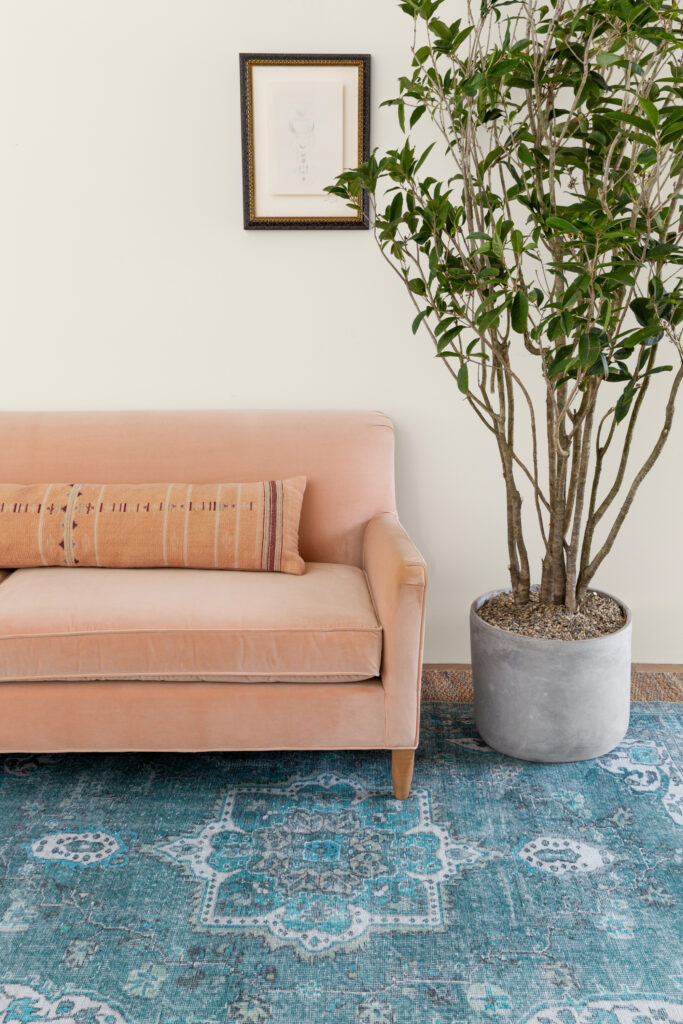
A pop of blue in the Harman collection’s Tamara rug, which is kid and pet friendly and easy to care for thanks to its polyester construction


